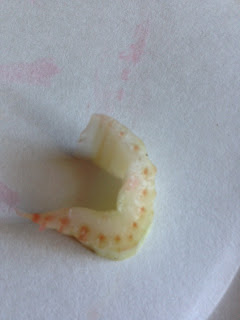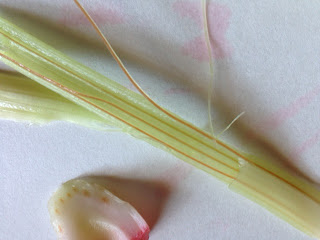I put 6 stalks of celery, enough for each group, in red water over night. I took it out of the water and brought it to take to class the next day. I also brought 6 pieces that had not been in the red water. I showed the students the piece of celery and asked why it was red? We compared it to a piece of celery that was not red. I explained that the base of the celery was put in a cup of water with red dye. Why did that make the celery red? we examined a slice of the celery. students were able to pull "strings" off of the celery. They used a hand lens to see the red holes. What did they think those were?
I asked the students to make speculate, make a claim in their notebooks of what they thought happened to cause the celery to turn red.
They shared with their tables. They then were assigned the task of creating an experiment that would test whether or not their explanation was correct.
Transport Systems in plants - With celery
For this experiment, we need:
4 stalks celery
4 classes - marked with masking tape for measuring water levels.
200 mL water
red food coloring
Students discussed that the roots absorb water and the xylem transports water and nutrients to other parts of the plant.
Students predict that the water in the cup will be absorbed in the celery. The water level will decrease (amounts differed), and the leaves will turn red.
Procedures:
There will be a control. A cup with 200 mL red water only.
A second cup with 200 mL red water with one celery stalk without leaves.
A third cup with 200 mL red water with one celery stalk with leaves.
A fourth cup with 200 mL red water with one celery stalk upside down.
After one hour, the students noticed that there were little red circles or dots on the end of the celery, where the roots used to be. The water level didn't change.
At the end of the day, the students noticed that there were lines that appeared reddish. the water level was slightly lower.
The following day. The celery had dark lines through the stalk. The leaves were red. We could cut out these threads. The students determined that these were like straws, bringing the water to the leaves.
The cup of water only did not lose water. This means that the water in the cups with the celery was not lost due to evaporation. The celery with the leaves took in more water. The other cups lost about a half inch. The upside down celery still had some red, however, it was less.
Capillary action - link
Flower Parts Quiz
Parts of a Flower identification



No comments:
New comments are not allowed.